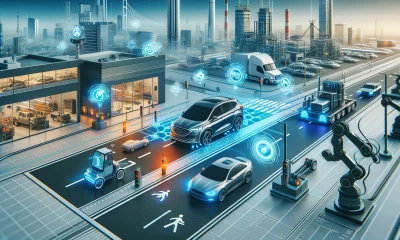Artificial Intelligence
Empowering Large Vision Models (LVMs) in Domain-Specific Tasks through Transfer Learning

Computer vision is a field of artificial intelligence that aims to enable machines to understand and interpret visual information, such as images or videos. Computer vision has many applications in various domains, such as medical imaging, security, autonomous driving, and entertainment. However, developing computer vision systems that perform well on different tasks and domains is challenging, requiring a lot of labeled data and computational resources.
One way to address this challenge is to use transfer learning, a technique that reuses the knowledge learned from one task or domain to another. Transfer learning can reduce the need for data and computation and improve the generalization and performance of computer vision models. This article focuses on a specific type of computer vision model, called Large Vision Models (LVMs), and how they can be leveraged for domain-specific tasks through transfer learning.
What are Large Vision Models (LVMs)?
LVMs are advanced AI models that process and interpret visual data, typically images or videos. They are called “large” because they have many parameters, often in the order of millions or even billions, that allow them to learn complex patterns and features in visual data. LVMs are usually built using advanced neural network architectures, such as Convolutional Neural Networks (CNNs) or transformers, that can efficiently handle pixel data and detect hierarchical patterns.
LVMs are trained on a vast amount of visual data, such as Internet images or videos, along with relevant labels or annotations. The model learns by adjusting its parameters to minimize the difference between its predictions and the actual labels. This process requires significant computational power and a large, diverse dataset to ensure the model can generalize well to new, unseen data.
Several prominent examples of LVMs include OpenAI ‘s CLIP, which excels in tasks like zero-shot classification and image retrieval by understanding images through natural language descriptions. Likewise, Google’s vision transformer adopts a transformer-like architecture for image classification, achieving state-of-the-art results in various benchmarks. LandingLens, developed by LandingAI, stands out for its user-friendly platform, which enables custom computer vision projects without coding expertise. It employs domain-specific LVMs, demonstrating robust performance in tasks like defect detection and object localization, even with limited labeled data.
Why Transfer Learning for LVMs?
LVMs have shown remarkable capabilities in understanding and generating visual data but also have limitations. One of the main limitations is that they are often trained on general-purpose datasets, such as ImageNet or COCO, that may differ from the specific task or domain the user is interested in. For example, an LVM trained on Internet images may not be able to recognize rare or novel objects, such as medical instruments or industrial parts, that are relevant to a specific domain.
Moreover, LVMs may not be able to adapt to the variations or nuances of different domains, such as other lighting conditions, camera angles, or backgrounds, that may affect the quality and accuracy of the model's predictions.
To overcome these limitations, transfer learning can utilize the knowledge learned by an LVM on a general-purpose dataset to a specific task or domain. Transfer learning is fine-tuning or adapting an LVM to the user’s needs, using a smaller amount of labeled data from the target task or domain.
Using transfer learning offers numerous advantages for LVMs. One key benefit is the ability to transfer knowledge from diverse visual data to specific domains, enabling faster convergence on targeted tasks. Moreover, it mitigates data dependency issues by utilizing pre-trained models’ learned features, reducing the need for extensive domain-specific labeled data.
Moreover, initializing LVMs with pre-trained weights leads to accelerated convergence during fine-tuning, which is particularly advantageous when computational resources are limited. Ultimately, transfer learning enhances generalization and performance, tailoring LVMs to specific tasks and ensuring accurate predictions, fostering user satisfaction and trust.
How to Transfer Learn for LVMs?
Different approaches and methods exist to perform transfer learning for LVMs, depending on the similarity and availability of the data between the source and target tasks or domains. There are two main approaches to transfer learning, namely, inductive and transductive transfer learning.
Inductive transfer learning assumes that the source and target tasks differ, but the source and target domains are similar. For example, the source task could be image classification, and the target task could be object detection, but both tasks use images from the same domain, such as natural scenes or animals. In this case, the goal is to transfer the knowledge learned by the LVM on the source task to the target task by using some labeled data from the target task to fine-tune the model. This approach is also known as task transfer learning or multi-task learning.
On the other hand, transductive transfer learning assumes that the source and target tasks are similar, but the source and target domains are different. For example, the source and target tasks could be image classification, the source domain could be Internet images, and the target domain could be medical images. In this case, the goal is to transfer the knowledge learned by the LVM on the source domain to the target domain by using some labeled or unlabeled data from the target domain to adapt the model. This approach is also known as domain transfer learning or domain adaptation.
Methods for Transfer Learning
Transfer learning for LVMs involves various methods tailored to different modification levels and access to model parameters and architecture. Feature extraction is an approach that utilizes the features known by the LVM on a source task as input for a new model in the target domain. While not requiring modifications to the LVM’s parameters or architecture, it may struggle to capture task-specific features for the target domain. On the other hand, fine-tuning involves adjusting LVM parameters using labeled data from the target domain. This method enhances adaptation to the target task or domain, requiring parameter access and modification.
Lastly, meta-learning focuses on training a general model capable of rapid adaptation to new tasks or domains with minimal data points. Utilizing algorithms like MAML or Reptile, meta-learning allows LVMs to learn from diverse tasks, enabling efficient transfer learning across dynamic domains. This method necessitates accessing and modifying LVM parameters for effective implementation.
Domain-specific Transfer Learning Examples with LVMs
Transfer learning for LVMs has demonstrated significant success across diverse domains. Industrial inspection is a domain that requires high efficiency and quality in computer vision models, as it involves detecting and locating defects or anomalies in various products and components. However, industrial inspection faces challenges such as diverse and complex scenarios, varying environmental conditions, and high standards and regulations.
Transfer learning can help overcome these challenges by leveraging pre-trained LVMs on general-purpose datasets and fine-tuning them on domain-specific data. For example, LandingAI’s LandingLens platform allows users to create custom computer vision projects for industrial inspection without coding experience. It uses domain-specific LVMs to achieve high performance on downstream computer vision tasks, such as defect detection or object location, with less labeled data.
Likewise, in the entertainment industry, transfer learning contributes to creativity and diversity in computer vision models. OpenAI's CLIP model, designed for tasks like image generation from textual descriptions, allows users to create diverse visual content, such as generating images of “a dragon” or “a painting by Picasso.” This application shows how transfer learning empowers generating and manipulating visual content for artistic and entertainment purposes, addressing challenges related to user expectations, ethical considerations, and content quality.
The Bottom Line
In conclusion, transfer learning emerges as a transformative strategy for optimizing LVMs. By adapting pre-trained models to specific domains, transfer learning addresses challenges, reduces data dependencies, and accelerates convergence. The approach enhances LVMs’ efficiency in domain-specific tasks. It signifies a crucial step towards bridging the gap between general-purpose training and specialized applications, marking a significant advancement in the field.












